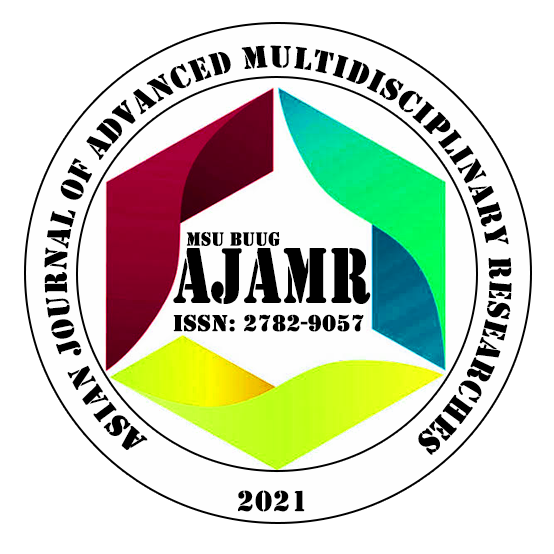

As part of the submission process, authors are required to check off their submission's compliance with all of the following items, and submissions may be returned to authors that do not adhere to these guidelines:
✓ The submission has not been previously published, nor is it before another journal for consideration (or an explanation has been provided in Comments to the Editor).
✓ The submission file is in OpenOffice, Microsoft Word, or RTF document file format.
✓ Where available, URLs for the references have been provided.
✓ The text is single-spaced; uses a 11.5-point font; employs italics, rather than underlining (except with URL addresses); and all illustrations, figures, and tables are placed within the text at the appropriate points, rather than at the end.
✓ The text adheres to the stylistic and bibliographic requirements outlined in the Author Guidelines.
The guidelines articulated here shall apply in preparing copy manuscripts. Researchers who desire to publish research papers in this Journal are encouraged to adhere to the formatting guidelines to avoid delay in the publication process. Major deviations from the format could render the copy manuscript unworthy of publication.
The research follows the general format of I - M - R - A - D.
1. PAPER SIZE, MARGINS, SPACING AND FONTS
2. PARTS OF THE COPY MANUSCRIPT
Title of the Study
Author(s)
Affiliation
ABSTRACT
KEYWORDS
1) Not less than 5 italicized key words
INTRODUCTION
METHODOLOGY
RESULTS AND DISCUSSION
REFERENCES
3. HEADINGS
The major headings (i.e., Abstract, Introduction, Method, Results, Discussion, References, etc.) should be typed centered on the page and capitalized, except for articles, short prepositions and coordinating conjunctions. Subheadings should be 1.5 double spaces (equivalent to 3 single spaces) before and after the first line of the following paragraph and the last line of the preceding paragraph, respectively.
Minor headings (e.g., Participants, Measures and Procedure subsections under Method) should be aligned left and typed in italics. Only the first letter of the minor heading should be capitalized. Subheadings should be 1.5 double spaces (equivalent to 3 single spaces) after the last line of the preceding paragraph and one double space (equivalent to 2 single spaces) before the first line of the following paragraph.
4. VISUALS
Visuals such as tables and figures (charts, graphs, drawings and photographs) must be as as simple as possible. They are labeled in Arabic numerals followed by the title.
For tables, the label must be on top and aligned left while the source is put below, while labels are placed aligned left below figures. Texts in tables could be reduced to 10 to fit within the margins.
5. IN-TEXT CITATIONS
The author-date method of in-text citation is used when referring to another work in the text. This is the author's last name and the year of publication written capitalized whether integrated into the text or placed in parenthesis after a signal phrase. This has a corresponding complete entry in the Reference list when referring to the entire work or when quoting directly from it. When referring only to an idea, it does not need to be included in the Reference list.
When placing the title of a work cited in the text, the following words must be capitalized: all words which have four letters or more, words with less than four letters, but are verbs, nouns, pronouns, adjective and adverbs, both words in hyphenated compound words and words after a dash or colon. Titles of entire books, edited works, motion pictures, television series, documentaries or albums are italicized or underlined, while those of shorter works like journal articles, articles from edited collections, episodes from a television series or song titles are typed with quotation marks. In-text citation styles would differ as to source:
6. FOOT-NOTES AND END-NOTES
This is space for long explanatory notes, bibliographic comments and additional information that are preferred to be omitted in the main text. Instead, a superscript numeral is placed in the text with the corresponding information either on the bottom of the page (footnote) or at the end of the paper (endnote).
7. REFERENCES
The Reference section is at the end of the paper containing complete information on how to access the sources you used in the writing of the paper. Each source then, must be entered into this list, except when not entire works are presented but only ideas are, in which case an in-text citation should suffice. Entries in this list must also likewise be cited in the text.
This list should start on a section separate from the body of the report, with the word "REFERENCES" typed centered on the page. This list would be typed double-space just like the rest of the paper. To enter a work cited, type the author or authors' last names first, followed by the initials of the first and middle names up to the sixth author, after which the rest of the authors will be signified with "et al." The list is in alphabetical order. Multiple works by the same author must be listed in chronological order, starting from the earliest, distinguished by assigned lower-case letters. Titles of longer works such as books and journals are italicized. For shorter works, such as journal articles and essays, the titles are not italicized, underlined are placed in quotation marks. All major words in journal titles are capitalized. For other types of sources, only the first word of a title or subtitle, the first word after a colon or a dash and proper nouns are capitalized while the second word in a hyphenated compound word is no longer capitalized.